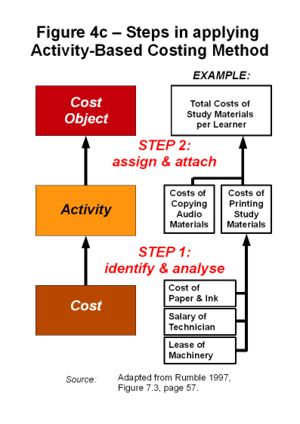Steps in Activity-Based Costing
| Unit 4 |
Introduction | Traditional Approach to Assigning Overheads | Critique of Traditional Methods of Cost Accounting | Activity-Based Costing | Steps in Activity-Based Costing | Critique of Activity-Based Costing |
Whereas conventional methods of cost accounting operate as top-down systems, activity-based costing works from the bottom up. Applying the ABC method involves two steps in order to trace costs back to activities and thence to the cost objects with which they can be associated. These steps are illustrated in Figure 4c:
The first step is to identify and measure all of the costs incurred in carrying out specific activities. Each category of resource (materials, labour and equipment) needs to analysed and assigned to the cost pool for a particular activity. You will need to determine:
- who carries out the work and how much time they devote to it;
- what materials are required for the activity,
- what equipment is used in the activity.
The unit cost for each of these resources needs to be calculated, so that the total cost of the activity can be determined.
The second step in the ABC process involves assigning and attaching the costs of the activity to cost objects (for example, the students registered for a particular course). In many cases, this analysis can be done for an individual unit of the cost object, but some activities (such as a face-to-face tutorial) will benefit two or more units at the same time. Still others (such as revising study materials) will benefit all of the units of a particular cost object simultaneously.
It is important to measure the actual demand for or use of the activity. For example, even though a particular course requires students to submit four assignments for marking, a number of students are likely to drop out or fail to submit some of their assignments. As a result, the actual number of assignments marked will average fewer than four per student.
|
Clarify the differences between the treatment of overheads using traditional cost accounting methods and the ABC approach by completing Exercise 4.2
|
Clearly the ABC approach produces a more realistic picture of the actual costs incurred for the activity of inspecting these products than traditional methods of cost accounting. Instead of adding 45 pence for inspection to the production costs of each kettle, only 25 pence is actually spent on this activity. On the other hand, since toasters require twice as many hours per batch to check, the full cost of inspection (50 pence) can be allocated to each unit produced. Using conventional cost accounting methods, the inspection cost apportioned and attached to each toaster was only 30 pence.
Nevertheless, some activities cannot be associated meaningfully with a particular cost object. For example, expenditure on hiring security guards for the head office of an ODL institution cannot be traced to a specific course or other service it provides. Such residual overheads are sometimes referred to as business-sustaining costs.
Business-sustaining costs in open schools, colleges or universities can be apportioned and attached to different courses through conventional methods. For example, these residual overheads can be divided equally among all of the students registered with the institution on the assumption that each benefits by approximately the same amount. Alternatively, they can be absorbed on the basis of the cost per student, which recognises that some courses consume more resources than others. This process is referred to as full cost absorption and is essential when determining fee levels with cost recovery approaches (see Unit 11).
